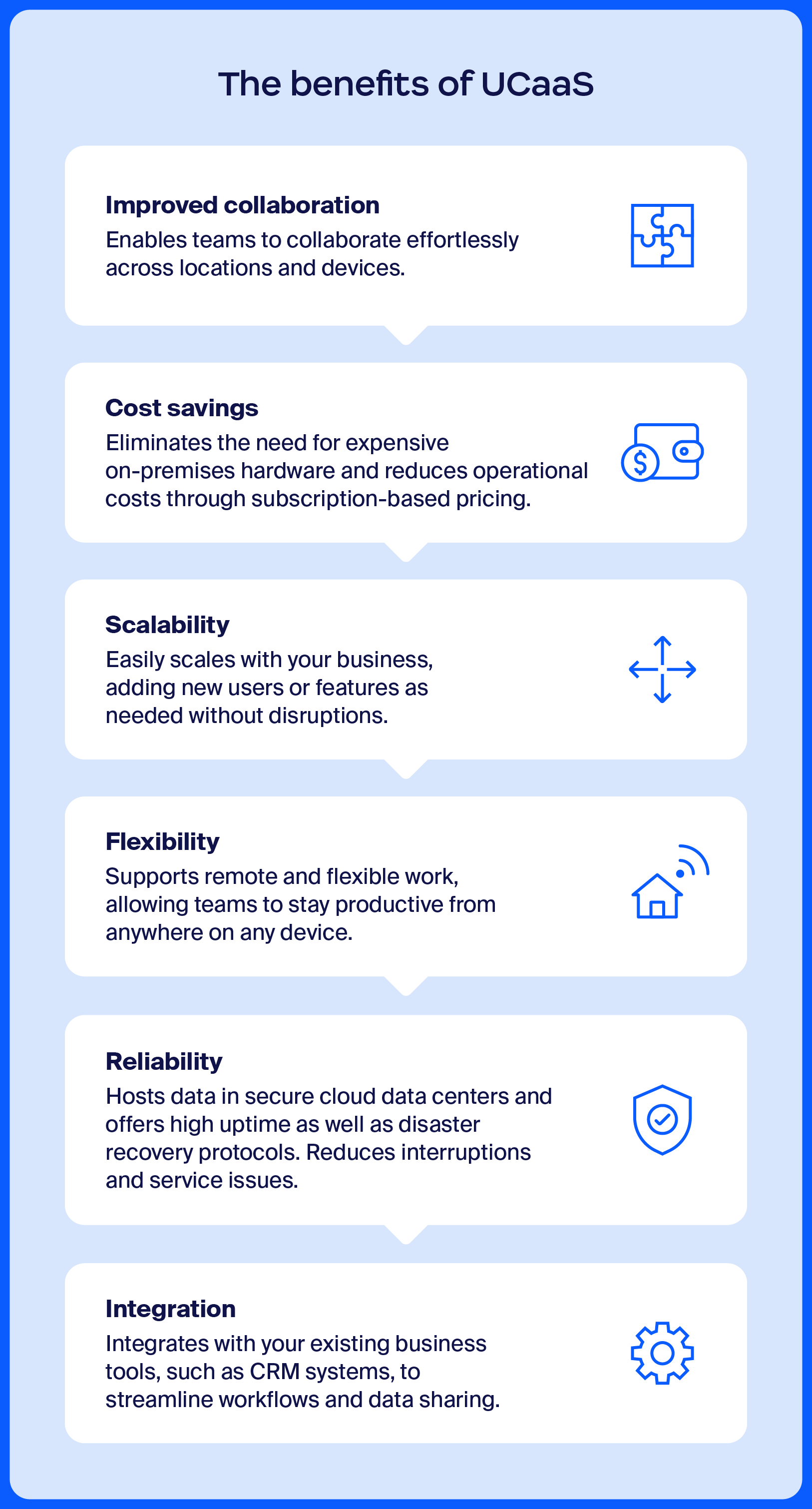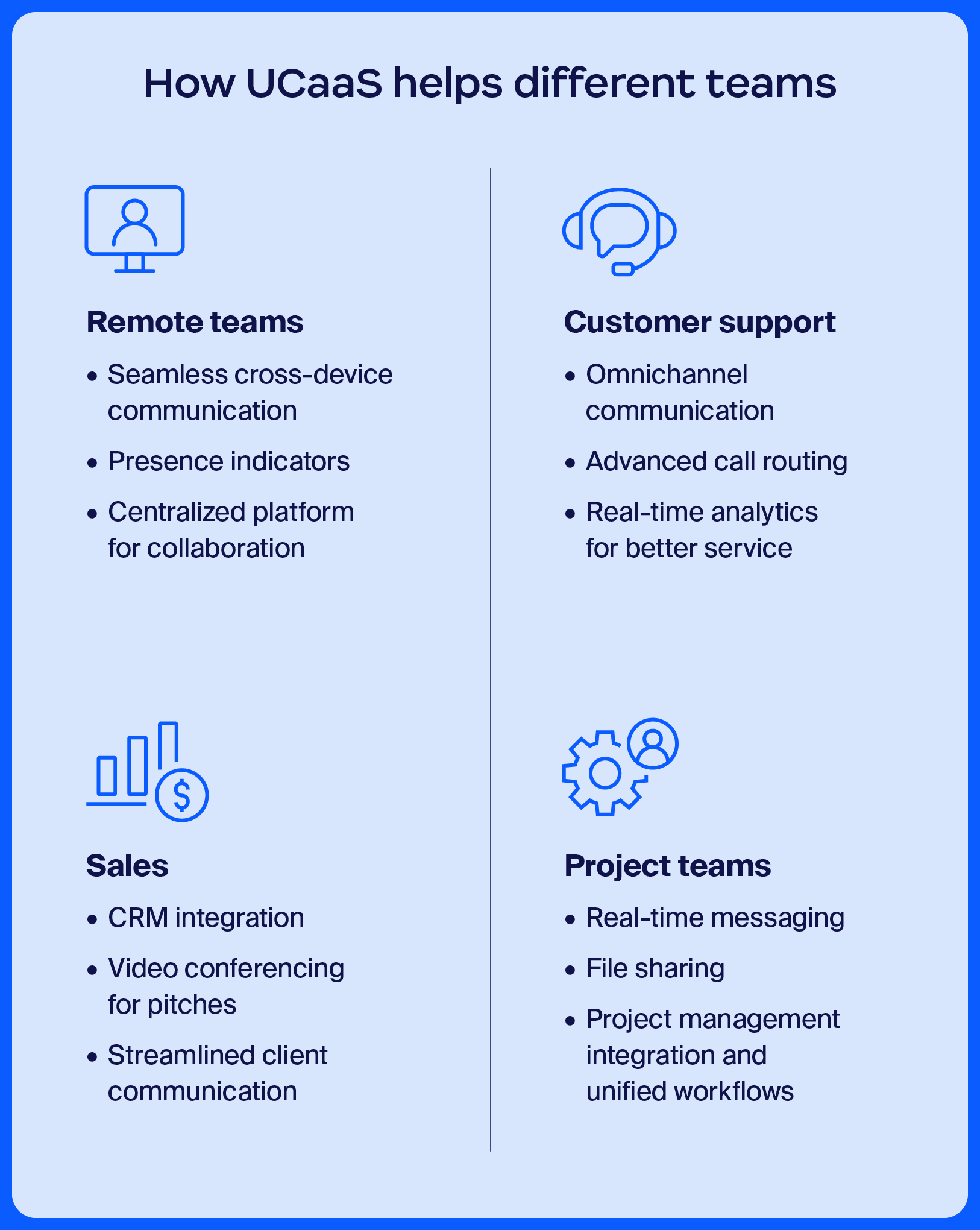
Meet Zoom AI Companion, your new AI assistant!
Boost productivity and team collaboration with Zoom AI Companion, available at no additional cost with eligible paid Zoom plans.
Updated on February 24, 2025
Published on February 24, 2025


In a world where remote and flexible work environments are becoming the norm, teams need reliable tools to stay connected, productive, and efficient — regardless of their location. Yet, traditional communication systems often fall short, leaving teams juggling multiple apps and struggling to keep up with the pace of modern business.
Unified communications as a service (UCaaS) has become an established solution for today’s workforce. By consolidating voice, video, messaging, and collaboration tools into one integrated platform, UCaaS empowers teams to communicate effortlessly and operate at peak efficiency. In this post, we’ll explore what UCaaS is, how it works, and how it’s transforming the way businesses operate.
Unified communications as a service is a cloud-based solution that combines essential communication tools like voice, video conferencing, messaging, and file sharing into a single, unified platform.
Unlike traditional on-premises systems, which rely on physical infrastructure and hardware, UCaaS is hosted in the cloud, allowing employees to access its features from anywhere with an internet connection. This flexibility is ideal for modern businesses, especially those with remote or flexible workforces.
The appeal of UCaaS platforms is that they integrate all key communication channels into one seamless experience. Imagine having your business phone system, chat, video meetings, and file-sharing tools all accessible through a single application on your laptop or smartphone. Whether making a VoIP call, brainstorming over a video conference, or sharing project updates through instant messaging, UCaaS eliminates the need to juggle multiple apps and devices.
For example, let’s say a marketing manager starts their day by joining a brainstorming session on a video call. During the call, they can share collaborative documents directly for co-editing. After the meeting, the manager uses the same app to message a colleague for feedback and call a client for approval — all without switching systems. UCaaS streamlines workflows, saves time, and keeps teams connected, no matter where they are.

At its core, UCaaS is powered by cloud technology, which enables businesses to access communication and collaboration tools over the internet in secure data centers instead of relying on physical servers or hardware.
One of the key technologies behind UCaaS is voice over internet protocol (VoIP). VoIP converts voice signals into digital data, allowing employees to make phone calls over the internet rather than traditional phone lines. By combining VoIP with video conferencing, instant messaging, and file sharing, UCaaS platforms offer a comprehensive suite of tools that work together to streamline communication.
UCaaS platforms also utilize application programming interfaces (APIs) to integrate with other business tools and applications. These integrations help users sync their communication platform with CRM software, project management tools, and other essential systems. For example, sales teams can use UCaaS integrations to make calls directly from their CRM while automatically logging interactions, saving time, and enhancing productivity.
UCaaS is designed to be intuitive and accessible for teams. With a single interface, employees can access all communication tools without switching between apps. Features like cross-device compatibility mean employees can start a video call on their laptop, continue it on their smartphone, and pick up the conversation later on a tablet. The ability to centralize communications, coupled with simple integrations, means UCaaS can meet the demands of a modern, fast-paced workplace while remaining easy to use.

UCaaS offers a range of transformative benefits that enhance how teams communicate and businesses operate. From improving collaboration to reducing costs, here’s how UCaaS can elevate your organization:
These benefits not only simplify operations but also help teams to focus on what matters most: delivering results and driving business growth.

UCaaS is versatile, offering specific advantages tailored to the needs of different teams within your organization. Whether you’re managing remote employees, customer service agents, sales staff, or project teams, UCaaS enables seamless communication, efficiency, and productivity.
For remote teams, UCaaS serves as a lifeline, connecting employees across locations and time zones. Its cloud-based nature means remote workers have consistent access to essential tools like video conferencing, messaging, and file sharing, whether they’re at home, in a coworking space, or traveling.
Features like cross-device compatibility and presence indicators (a real-time, visual representation of your team members’ availability) help remote workers stay in sync with their teams, making it easier to collaborate. By centralizing all communication on one platform, UCaaS eliminates the friction caused by juggling multiple tools so remote teams remain productive and aligned.
Customer support teams thrive on responsiveness, and UCaaS provides the tools they need to deliver exceptional service. With integrated omnichannel capabilities, agents can handle customer inquiries via phone, email, or chat — all from a single platform.
UCaaS also supports features like call routing and analytics so customers are directed to the right agent quickly while supervisors have insights into agent performance and customer satisfaction. This not only improves the customer experience but also helps agents resolve issues faster, boosting first-contact resolution rates.
Sales teams benefit greatly from UCaaS, which simplifies client communication and helps enhance productivity. By integrating with CRM tools, UCaaS allows sales representatives to make calls, track conversations, and log updates directly within their CRM system, saving time and reducing manual effort.
Additionally, features like video conferencing enable virtual pitches, demos, and consultations with prospects, creating a seamless experience for both sales reps and clients. With UCaaS, sales teams can close deals faster and maintain stronger relationships with customers.
Project teams rely on consistent communication and collaboration to stay on track, and UCaaS delivers just that. With tools like instant messaging, file sharing, and virtual meetings, team members can easily share updates, brainstorm ideas, and tackle issues in real time.
UCaaS also supports integrations with project management platforms, allowing teams to keep all communication and task tracking in one place. This centralized approach is designed to help so that everyone remains aligned, deadlines are met, and workflows run smoothly, regardless of whether the team is in the office or distributed across multiple locations.
Choosing the right UCaaS provider helps your business get the tools and reliability it needs. Here’s how to assess your options:
Zoom Workplace, our AI-first UCaaS platform, combines voice, video, messaging, collaboration tools, and more into one seamless solution. With secure cloud infrastructure, reliable uptime, and integrations with essential business tools, Zoom Workplace helps your team stay connected and productive.
Request a free demo and see for yourself how much more productive your team can be with Zoom Workplace.
UCaaS focuses on internal team communication (voice, video, and messaging), while CCaaS (contact center as a service) specializes in customer-facing tools like call routing and support analytics.
UCaaS requires stable internet, can involve scaling costs, and requires user training for effective adoption.
VoIP is a technology that allows users to make phone calls using an internet connection instead of a landline, while UCaaS is a cloud-based service that combines multiple communication methods like video conferencing and messaging into a unified communication platform.